|
|
Ensign Auto Kinecam - produced from early thirties
The camera was produced by Houghton-Butcher, in England, Walthamstow. The long established and largest British manufacturer of photographic equipment marketed in the 20s a range of projectors and still and moves cameras. In 1941, the factory was bombed. Production of the equipment ceased, after the war the Walthamstow factory was rebuilt, but post war production of movie cameras or projectors was not continued. The factory was finally closed in the 50s. It was a dramatic closing because just after closing the Company technical expert committed suicide.
In 1935 the camera had won the ‘Daily Mail’ Challenge as the best film -’Happy Day’ taken with an Ensign Kinecam. Next in March 1936 the camera had won the premier award in the Home Movie Section of the “American Cinematographer”. The advertisement placed in ‘Amateur Cine World’ March 1936:
 |
The body construction is of die casting with a black crackle finish. Its shape is particularly suitable for hands holding, the front of the base plate being used as a form of pistol grip.
Features:
- Lenses: Taylor-Hobson Cinar Leicester f/2.6; Meyer Görlitz Nr 698654 Trioplan F:2.8 f=5 cm; Standard C mount lenses are used;
- The viewfinder is tubular, giving a reduced image, and has no provision for parallax correction; our camera has a folding viewfinder on the door, which is adjustable for parallax: 15 mm, 25 mm, 75 mm fields of view.
- The double spring motor runs between 30 and 35 ft of film on one wind, before slowing down and stopping.
- The camera takes 100 ft spool of double perforated 16 mm film;
- The release button has unusual features; the running speed is dependent entirely on how far the release button is depressed, making it essential to always press the button down firmly. - Speed: 8, 16, 64 fps - can be locked to prevent accidental exposure. There is no provision for continuous running or single frames;
- There is provision for backwind - 8 frames per turn hand crank. The same handle used for winding the motor is used for hand cranking, either forward or back.
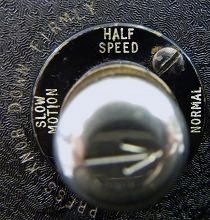 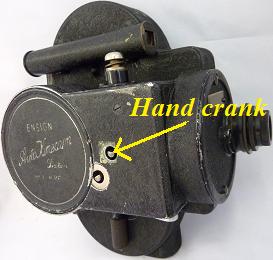
- Double perforation of the sprocket quid;
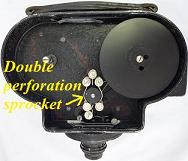
The camera is in original leather box in the factory logo on the lid - ‘Ensign’.
The camera is included with a few pages of correspondence between the last owner of the camera and the Company - ‘Photography and Sound Recording’ in Darlington; dated 16/04/60. The Company informs: ‘the camera has been recently in use for Television Newsreel filming for the BBC at 24 fps’.

In 1950s enthusiasts of the camera, in the USA and UK, made some experiments mounting the camera to be used with binoculars and prismatic telescopes - look on the pictures on the right.
Production number of the camera: 3327.
|
Experiments:
|
|
|
|
|
|
|
|
AK 16 - DDR
This camera is unusual in a way. When Germany was divided after the war, East Germany would like to built a reflex camera, similar to well known Arriflex camera (in our collection - 35 mm). At the same time on the market appeared 16 mm Arriflex camera.
It was designed for 16 mm film, named - AK 16 .
The camera looks very nice, but it is difficult to used it as a hand camera.
Our camera was produced in DDR, ca 1953, by VEB Kinowerke, Dresden, East Germany (Schandauer Strasse 48, Dresden).
 
Pict 1, 2; AK 16 camera in our collection. © Anna Vacani
Pict 3; AK 16 camera and accessories, in our collection. © Anna Vacani
The shortest history of the Company;
The name of the Company was changed many times, because of the merges with other Companies.
- In 1958 several camera manufacturers were united and the factory was named as VEB (Volkseigener Betrieb; abbreviated VEB) Kamera und Kinowerke Dresden.
- In 1964 the factory was renamed to VEB Pentacon Dresden
- In 1990 was German reunification, and the factory was placed into liquidation. The production comes to an end in June 1991.
Some assets and Pentacon brand name were sold. Production of the cameras and lenses is continues in South Korea.
The Company had a logo, which was placed on the cameras.
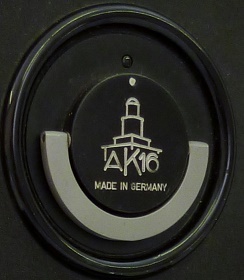 |
Pict 4; The Company logo placed on our camera. © Anna Vacani
In 1955 the camera was upgrade to Pentaflex 16.
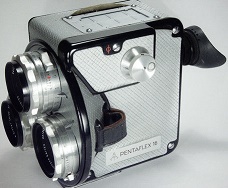
Pict 5; Pentaflex 16
The camera was produced in continuously partly upgraded versions for many years, presumably to the end of 1970s.
It was well known in the socialist countries, in Western Europe was not popular.
In the USSR, camera was supplied in large quantities, and it had possessed almost all studios and TV centers of the country, using the motor 25 fps. For individuals film users camera was not practical, because of the large size weight, and high cost - over 3000 rubles, at the time.
The camera with accessories was sold in a special case.
Pict 6; AK 16 camera and accessories in the case. Copyright picture Thomas Sadewasser
Our camera does not have case and many accessories, as;
- synchronous motor for television images (25 fr/s)
- clockwork motor
- single frame adapter
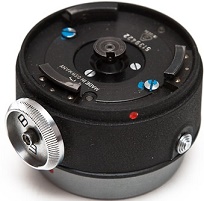  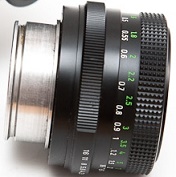
Pict 7 a, b, c ; AK 16 - accessories - frame, compendium-frame, adapter . Copyright pictures Thomas Sadewasser
- Normal magazine (N), only 2 magazine (R) 30 meters- for the revers use (Pict 1,2,3) .
- Handle attachable to the motor flange.
- Retractable two-pieces compendium with filter holder and front-loading ( Pict 7 b);
- Chest stand for down the next motor
- M42 lens adapter ( Pict 7 c)
- Leather case with a molded liner for the camera and accessories.
- Accumulator with bag
 Pict 8; Accumulator with bag for AK 16 - picture from the instruction book. Pict 8; Accumulator with bag for AK 16 - picture from the instruction book.
Camera features:
- Construction and finished
The camera is very heavy, because it is built from die casting and has steel parts as well. The camera has carved black enameled edges around the body with inset imitation leather covering.
The motor is built from similar material and brass parts. On the camera body are placed two inputs for the motor; on the side and underneath (Pict 2).
On the camera body are placed- Company logo and over it is a quality product, impressed into the synthetic leather covering.
Under the viewfinder is table of shutter openings in degrees, with showing frame per second speed (fps), and shutter speed.
- Type of loading and transit mechanism
The camera is fitted with replaceable cassettes 30, 60 and 120 m. In the cassette is the film lacing path
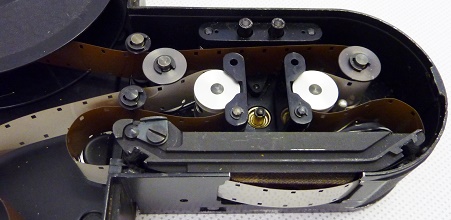 
Pict 9; The film loaded in the cassette & film counter. © Anna Vacani
The mechanism of inserting cassette is not complicated as it is on Arriflex camera (in our collection). In the picture No 2, it is visible the key, which looks like the winding key. Turning the key to the white dot, the cassette slot became opened. Insert the cassette and turn key to the previous position.
The cassette is fitted with the film counter (Pict 2). The scale of the meter counter is connected to the swinging arm, which rest on the film spool, inside of the cassette. .
- Speeds
filming speed: 12, 16, 20, 24, 32 fps. The speed is adjustable on the motor end (Pict 10).
- Motor and mechanism
Our camera has only an electric motor in the handle - 12 volts 10 Amps. The motor is very large comparing with Arriflex motor. The Arriflex motor is about 4 Amps.
On the side of the motor is placed the starter button of filming.
To run the motor it has to be connected with a special cable, that plugs in to the motor and to the accumulator.
The verbal shutter control, placed on the side of the camera (Pict 1), is adjustable from 0 opening to 180 degrees.
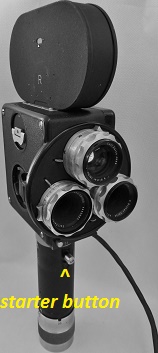 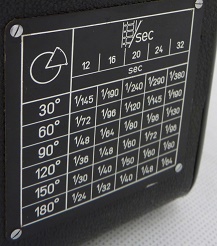
Pict 10; The motor is fitted to the bottom of the camera & exposure table. © Anna Vacani
Viewfinder
The viewfinder is adjustable for eyesight correction; + - 0 - 4 diopter. A reticule is inserted into viewfinder.
The scenery, in front of the camera, is visible only when the shutter is opened. You can open the shutter without running motor, turning the knob in the side motor slot.
Lenses
The camera has the triple turret with three lenses. They are in non standard mount. All lenses are made by Carl Zeiss Jena;
- Biotar 1,4/50; Production number -4468716;
- Flektogon 2,8/12,5; Production number - 4663627
- Biotar 1,4/25; Production No - 4468129.
These three lenses are connected by a mechanism accessible inside the turret, it provides synchronized mounting aperture on all lenses.
 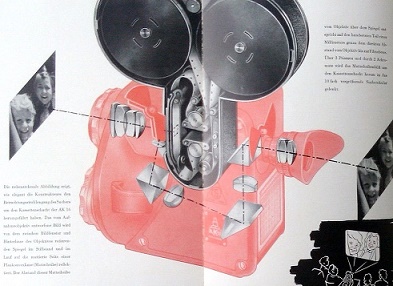
Pict 11; The triple turret with 3 lenses. © Anna Vacani ; and optic system of viewfinder - picture from catalogue 1955.
For this camera model were produced additional long-focus lenses.
The optic system showed above is unnecessary complicated by the fact of the magazine position in the body and the position of the viewfinder eyepiece.
This design adds extra weight to the camera.
Dimensions of the camera:
The camera weight with the motor but without film in magazine - 5100 gram (11 lb 4 oz)
Overall size of the body 170 mm (6 11/16”) [with the magazine 280 mm] x 140 mm (5 33/64”) x 80 mm (3 5/32”)
Production serial number: 01154; the camera and the motor have the same production number
For this motor was produced a special irreplaceable cable, with special connectors.

Pict 12; The motor with cable. © Anna Vacani
The camera, as far as we know, was never imported into The UK.
The instruction book you can read on the site: http://www.museum-digital.de/san/documents/30141428083.pdf
|
|
|
|
|
|
|
|
|
|
|
|
|
Page Back Pages: (1) (2) (3) (4) (5)
|
|
|
|